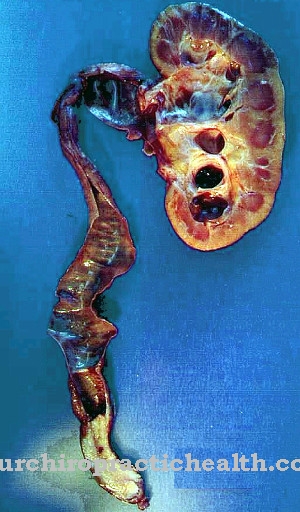In the Fournier gangrene it is a disease associated with fasciitis in the genital and groin area. Fournier's gangrene is a rare disease that is triggered by an infection. The pathological changes are characterized by necrosis.
What is Fournier gangrene?

© catinsyrup - stock.adobe.com
Fournier's gangrene is an infection in the genital area and the groin area that is associated with necrosis. It is a serious disease that threatens the life of a patient with Fournier's gangrene. The cause of the disease is an infection, which is usually a mixed infection. Anaerobic and aerobic bacteria are responsible for the inflammation.
The infection spreads from the anus, rectum, skin, or urinary tract. Fournier gangrene was first described by the dermatologist Jean Fournier and named after him. Basically, Fournier gangrene is a special form of what is known as necrotizing fasciitis.
The genitals and perineum are usually affected. Studies show that Fournier's gangrene occurs around ten times more often in male patients than in women. In numerous cases there are links to systemic diseases such as cirrhosis of the liver or diabetes mellitus.
causes
The causes of Fournier's gangrene have been researched relatively well. The triggering factor of the disease is usually an infection with certain types of bacteria. These pathogens first affect the urinary tract or the colorectal region.
Starting from the corresponding areas, the inflammation spreads to the fascia. In the majority of cases, the causative bacterial germs are streptococci. In addition, mixed infections are very common.
Symptoms, ailments & signs
The Fournier gangrene shows various signs and symptoms in the sick people. However, it is characteristic of Fournier gangrene that the symptoms tend to be unspecific, especially at the beginning of the disease. As a result, the diagnosis of Fournier's gangrene can be significantly delayed, which has a negative effect on the prognosis of the disease.
The first signs of Fournier's gangrene are usually pain in the genitals and perianal region. In addition, the affected people feel an unpleasant itching in the corresponding areas. As Fournier's gangrene progresses, swollen and reddened sections develop in the region of inflammation. Then the skin of the affected parts of the body changes, with edematous areas, for example.
In addition, gangrenous abnormalities appear. In the later course of Fournier's gangrene, the affected patients suffer sepsis. This phenomenon gives rise to other general symptoms such as tachycardia and fever. A diagnosis of Fournier's gangrene at this stage is urgently required so that appropriate treatment can be initiated immediately.
diagnosis
The diagnosis of Fournier gangrene is made taking into account the clinical symptoms of the individual case. Many patients wait too long before they consult a doctor, despite obvious symptoms. A quick diagnosis of Fournier's gangrene is all the more important so that the course of the disease is influenced as positively as possible.
The first step in diagnosing Fournier gangrene is to talk to the patient. Here the sick person explains their symptoms and gives the doctor an insight into their general lifestyle. The reference to possibly existing chronic diseases, such as diabetes mellitus, corroborates the suspicion of Fournier gangrene.
The doctor also inquires about and analyzes other living conditions of the patient. General risk factors such as obesity, smoking or the consumption of alcohol also play a role. The clinical examination usually begins with a gaze examination by the attending physician. He examines the affected areas of the body and possibly takes tissue samples of the skin.
In addition, the doctor draws blood from the patient and arranges for laboratory analyzes to identify specific inflammation markers and other deviations from normal values. An elevated blood sugar level indicates undiscovered diabetes mellitus, which in some cases promotes Fournier gangrene.
Complications
Complications in Fournier's gangrene can occur especially if the disease is not identified early. This happens because the symptoms of the disease are very general and do not lead directly to Fournier gangrene. A delayed diagnosis can lead to secondary diseases.
In most cases, the patients experience pain in the genitals. The affected areas are very itchy and the skin is reddened. The symptoms restrict the patient's sexual activity, which can lead to mood swings and depression. The affected skin areas can become inflamed.
Scratching will usually make itching worse. If Fournier's gangrene is left untreated, a fever will develop. Treatment must be carried out as soon as possible. This requires a surgical procedure in which the necroses are removed. After removal, there are usually no further complications.
Usually, the patient must take antibiotics even after the operation to avoid inflammation. If Fournier's gangrene is left untreated, death will result in many cases. Treatment is ineffective if the disease continues to a large extent.
When should you go to the doctor?
Medical treatment is always necessary for Fournier gangrene. As a rule, the disease does not heal itself, so that an examination by a doctor is always necessary. However, since the symptoms are very unspecific at the beginning of the disease, there is often no early diagnosis and treatment. A doctor should then be seen if the person has pain in the genital area. This pain occurs suddenly and often for no particular reason.
Unpleasant itching or redness in this region can also indicate Fournier's gangrene and should also be examined if they occur over a long period of time. These are also accompanied by swelling or inflammation. If Fournier's gangrene is not treated, the affected person can, in the worst case, die of blood poisoning.
Fever or general fatigue can also indicate the disease and should be examined. The diagnosis and treatment of this condition can usually be done by a urologist. In emergencies or in very severe pain, a general practitioner or a hospital can be visited.
Doctors & therapists in your area
Treatment & Therapy
As soon as Fournier's gangrene has been diagnosed with certainty, immediate treatment measures are required to counteract the further spread of the disease. In the majority of cases, the sick patients undergo an operation in which the areas of the body affected by the necrosis are removed.
Often several interventions are possible in order to reach all pathologically altered areas. At the same time, the people receive drug therapy with antibiotics. Clindamycin and meropenem are often the first choice. The prognosis of the disease essentially depends on the stage at which Fournier's gangrene is diagnosed and adequately treated.
However, Fournier's gangrene is fatal in about a fifth of all people, even if treated appropriately. Basically, the average mortality in unfavorable cases is around 67 percent. The rapid therapy with antibiotics and the radical removal of the diseased areas by surgical interventions are almost ineffective.
Outlook & forecast
An existing Fournier gangrene is an inflammation in the genital area. The prospect of a complete cure depends very much on whether medical or medicinal treatment is taking place. At the first symptoms of Fournier's gangrene, a doctor should definitely be consulted.
This can make the entire course of the disease much easier. Fournier's gangrene can be relieved within a short time with anti-inflammatory drugs. After two to three days you should see a clear and visible improvement.
The prospect and prognosis of a complete healing is completely different without professional help. If not treated at all, there is a risk of dangerous or life-threatening inflammation. The inflammation can spread to the entire genital area, which can even lead to the formation of an abscess. In particularly bad cases, this results in blood poisoning, which must be treated by a doctor.
prevention
Preventive measures of Fournier gangrene take into account the favorable factors of the development of the disease. This is, for example, an existing diabetes disease. However, successful prevention of Fournier gangrene is not always possible, as people with weakened health are particularly susceptible to the bacterial germs that cause Fournier gangrene.
Aftercare
In most cases of Fournier gangrene, the patient has no measures or options for follow-up care. For this reason, the affected person is first of all dependent on direct and medical treatment for Fournier's gangrene so that further necrosis or further complications occur. An early diagnosis with early treatment always has a positive effect on the course of Fournier's gangrene and can prevent further complications.
In some cases, surgical interventions are necessary, whereby the affected areas are removed. After such an operation, the patient should always rest and not strain himself unnecessarily. You should therefore refrain from strenuous activities or other stressful or sporting activities. Furthermore, in Fournier gangrene it is necessary to take antibiotics, although antibiotics must not be taken together with alcohol.
The exact dosage and intake must be observed so that the infection is treated correctly. As a rule, the patient with this disease also depends on the support and care of their own family or friends. Since the disease cannot always be cured, it is possible in some cases that the person concerned has a reduced life expectancy.
You can do that yourself
Since skin damage and poor immune defenses are responsible for Fournier's gangrene, the person affected should be active in both areas.
In everyday life, wounds on the skin must always be treated sterile. As soon as there are open wounds on the body, they should be cleaned and protected from intruders and pathogens. If this does not succeed to a large extent, a doctor should be consulted. This cleans the wound and ensures sterile wound care. The patient then receives tips and important information on how to change the dressing correctly.
To strengthen the immune system, the organism needs a healthy lifestyle. A balanced diet rich in vitamins is necessary for this. Carbohydrates, sugar and animal fats should be reduced. Fiber, fish, and fresh fruits and vegetables are all supportive for the body. The consumption of stimulants such as nicotine or alcohol should be avoided.
Sufficient mineral water brings the fluid balance into balance. In addition, good sleep hygiene and exercise in the fresh air are important for building a stable immune system. Sports activities should take place at regular intervals and obesity and heavy physical strain should be avoided.
Since Fournier's gangrene can be fatal, it is necessary for the person affected to contact a doctor at the first signs of the disease.

.jpg)























.jpg)


